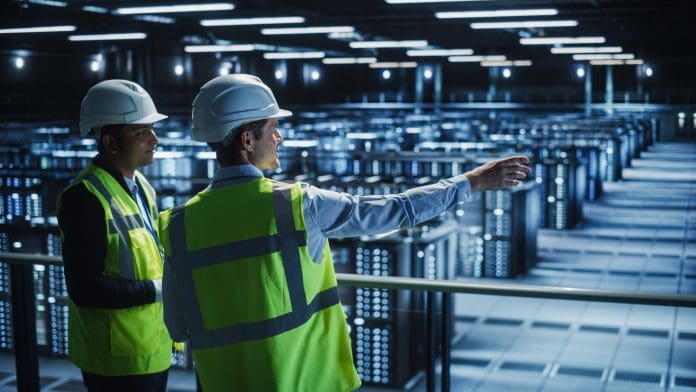Get insights into data centre construction projects, from site assessments to sustainability, and discover how to ensure seamless execution and future-proofing strategies
Data centre construction projects include thorough site assessments, budget planning, and strategic location selection for best connectivity and disaster resilience. Key aspects include efficient power management, scalable floor designs, advanced cooling systems, and robust security measures.
Coordinating diverse expertise for smooth execution is essential, ensuring redundancy for uninterrupted operations and sustainability for long-term viability. Financial planning and cost control are vital due to fluctuating market trends. Successful projects integrate detailed planning with innovative solutions to accommodate future growth and technological advancements.
Here, we explore how to understand the intricacies and infrastructure essentials of modern data centre development.
Project assessment
Project evaluation is an essential initial phase in data centre construction projects, often requiring comprehensive assessments to determine specific server requirements in alignment with cloud computing usage. This stage is crucial as it sets the foundation for successful project execution by guaranteeing that the infrastructure meets current and future demands.
One of the primary considerations is server capacity. Evaluating the server needs not only involves understanding the current data load but also anticipating future growth. This foresight helps in determining whether a hyperscale infrastructure or a simpler setup is appropriate, based on the organisation’s expansion plans. A miscalculation here can lead to costly upgrades or insufficient capacity, hindering performance and scalability.
Budgeting and costs
Effective budgeting and cost management are paramount to ensuring financial viability and project success when commencing data centre construction projects. The data centre construction market, valued at £15bn in 2020, is expected to grow to £24bn by 2027.
Given the 15% rise in project costs over the past year, accurate expense tracking is essential for staying within budget. Delays of more than 12 weeks for certain components further worsen financial challenges, making thorough cost management vital. Allocating funds effectively to cover unexpected delays and cost overruns can help mitigate financial risks.
Price negotiations play a crucial role in managing the overall budget. By securing favorable terms with suppliers and contractors, project managers can control costs and prevent budget inflation. Additionally, careful financial planning allows for the anticipation of future market trends, accommodating the projected tenfold increase in data centre usage between 2018 and 2050, as forecasted by Aecom.
Below is a table summarizing key budget considerations:
Choosing the location
Managing the budget and costs effectively sets the groundwork for subsequent stages, including the pivotal decision of choosing the location for data centre construction. The location of a data centre is paramount, impacting both operational efficiency and long-term viability.
First and foremost, water access and power access are crucial. Data centres require substantial and reliable power supplies to maintain server operations and cooling systems. Proximity to water sources can be beneficial for cooling needs, especially in large-scale facilities. Additionally, city proximity and fiber connectivity are fundamental factors; being near urban areas often ensures better access to high-speed internet and essential infrastructure.
Topography assessment and disaster risks must also be considered meticulously. The site’s physical characteristics, such as elevation and soil stability, can influence construction feasibility and costs. Furthermore, evaluating disaster risks—such as vulnerability to floods, earthquakes, and storms—is vital to safeguarding the data centre’s integrity.
Research on permits, deadlines, and construction costs is another essential step. Understanding local regulations and securing the necessary permits can prevent delays and additional expenses. Knowing the construction costs tied to a particular location helps in making an informed decision aligned with the budget.
Designing the infrastructure
Designing the infrastructure of a data centre is a critical step that demands a careful approach to guarantee operational efficiency and scalability. A well-thought-out infrastructure ensures that the data centre can handle current demands while being adaptable for future growth and technological advancements.
Efficient power management is paramount. The design must integrate power usage effectiveness (PUE) levels below two, which signifies an effective power system. Redundant power sources are essential to maintain continuous operations during outages, safeguarding data integrity.
Scalable floor plans are another cornerstone of data centre infrastructure. Implementing raised floors or rafter rooms allows for easy expansion and reconfiguration, accommodating future technological advancements without significant disruptions. These flexible designs ensure that the data centre can scale up as business needs evolve.
Airflow design is critical for maintaining ideal temperatures and preventing hot spots. Strategic airflow management, incorporating hot and cold aisle containment, contributes to effective cooling and cost efficiency. This design minimises energy consumption while maximising cooling performance.
Space navigation within a data centre is crucial for operational efficiency. Clear pathways and well-organised layouts facilitate easy access to equipment, reducing the time needed for maintenance and upgrades. Efficient navigation guarantees that staff can quickly and safely perform necessary tasks.
Lastly, cable storage solutions contribute to a clean and organised environment. Proper cable management systems prevent tangling and signal interference, hence enhancing operational reliability and ease of maintenance.
Power and cooling systems
Securing the reliability and efficiency of power and cooling systems is a cornerstone of data center construction. With data centers consuming approximately 3% of the world’s total electricity, achieving energy efficiency is crucial. This involves integrating sustainable solutions and advanced cooling technology to maintain peak operating temperatures while minimizing environmental impact.
One of the primary challenges in data center construction is temperature management. Efficient cooling systems are vital to prevent equipment damage and maintain stable operations. Water cooling and air conditioning units are commonly employed to regulate temperature levels. However, optimizing airflow design within the facility is equally important. Effective airflow management can greatly reduce energy costs and ensure efficient temperature regulation.
Redundancy planning is another crucial aspect of power and cooling systems in data centers. To guarantee uninterrupted operations, redundant power supplies and cooling systems are incorporated. This means that if one system fails, another can seamlessly take over, thereby maintaining the facility’s functionality. Such planning is essential for avoiding downtime and ensuring continuous data processing and storage.
Incorporating sustainable solutions into power and cooling systems is not only beneficial for the environment but also enhances the long-term viability of the data center. Utilising energy-efficient technologies and renewable energy sources can decrease the overall carbon footprint and operational costs.
Security measures
Effective security encompasses a thorough approach, integrating physical, cyber, and environmental protection systems.
Physical security measures include advanced surveillance cameras strategically placed to monitor all access points and sensitive areas. These cameras work in tandem with access controls, which limit entry to authorised personnel only.
High-tech solutions such as biometric access control are increasingly implemented to ensure that only verified individuals can enter specific zones within the data center. This not only enhances security but also provides a detailed audit trail of who accessed the facility and when.
In addition to physical security, robust cybersecurity measures are essential. Data centers employ a range of technologies, including firewalls and encryption protocols, to protect against cyber threats. These systems are designed to prevent unauthorized access, detect potential vulnerabilities, and respond swiftly to any incidents, guaranteeing that the integrity and confidentiality of the data are maintained.
Fire protection systems are another critical component of data center security. These systems include fire suppression technologies and lightning protection to prevent and mitigate the impact of potential fire-related disasters. Ensuring that fire protection measures are in place minimizes the risk of data loss and infrastructure damage.
Building Management Systems (BMS) monitor and manage the various security measures. These systems provide real-time alerts and enable quick responses to potential breaches or other security incidents, thereby maintaining the data center’s overall security posture.
Team collaboration
Effective communication strategies and interdisciplinary teamwork are pivotal in ensuring that all contributors are aligned with the project goals and timelines. A well-coordinated team can optimise efficiency, minimise errors, and deliver a high-quality data center facility.
To achieve seamless collaboration, strong communication strategies must be implemented. This includes regular meetings and the use of collaborative tools to facilitate real-time information sharing. Interdisciplinary teamwork fosters a holistic approach, where architects, engineers, and IT specialists work in tandem to address the intricate requirements of data center construction projects.
Task delegation is another critical aspect where roles and responsibilities are clearly defined to prevent overlaps and gaps. Each team member must understand their specific tasks and how they contribute to the overall project objectives. This clarity ensures that all components, from power supply to cooling systems, are meticulously planned and executed.
Effective conflict resolution techniques are essential to address disagreements and challenges that arise during the construction process. A proactive approach to conflict resolution can prevent delays and maintain project momentum. Finally, a well-structured decision-making process ensures that critical decisions are made efficiently and transparently, involving the right stakeholders at the right time.





